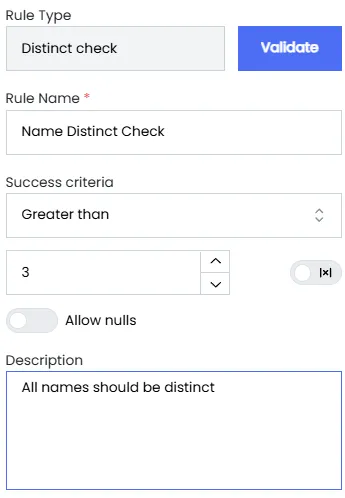Distinct check
Description
The Distinct Check rule ensures that a specific column contains distinct (unique) values. This rule verifies whether the values in a given column meet the configured success criteria based on the uniqueness of the values.
Configuration Fields
-
Operator Options
Greater thanLess thanEqual toBetween(requires specifying a start and end range)
-
Operator Defines the comparison operation (Greater Than, Less Than, Equal To, or Between).
-
Value The threshold value used for success criteria. Required for
Greater than,Less than, andEqual tooperators. -
Value Range Required only when the
Betweenoperator is selected, specifying thestartandendrange. -
Threshold Type Indicates whether the
ValueorValue Rangeto be considered as percentage or an absolute count. -
Allow Null Values Determines if null values are permitted.
Success Criteria
The success criteria are evaluated based on the number of distinct values in the column.
- If the column has N rows, the number of distinct values is calculated.
- The success condition is met if the distinct value count satisfies the given
operatorandvalue. - For example, if
operatorisGreater thanandvalueis3, then the column must have more than 3 distinct values to be within the threshold.
Sample Input
| ID | Name | Age |
|---|---|---|
| 1 | Alice | 25 |
| 2 | Bob | 30 |
| 3 | Alice | 25 |
| 4 | Charlie | 40 |
| 5 | Alice | NULL |
Sample Configuration
- Operator Greater than
- Value 3
- Threshold Type Absolute Count
- Allow Null Values False

Sample Output
| Column Name | Rule Name | Success Count | Within Threshold | Null Count |
|---|---|---|---|---|
| Name | Name Distinct Check | 3 | No | 0 |
| Age | Age Distinct Check | 3 | No | 1 |